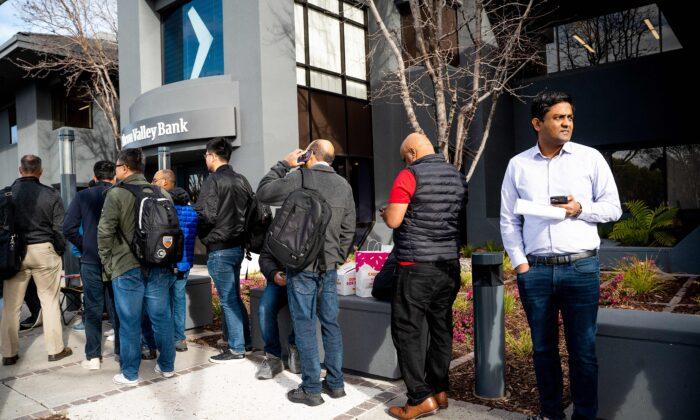Commentary
Bank runs, as they say, have a way of spiraling.
The first two bank failures, those of Silvergate Bank and Silicon Valley Bank (SVB), were the results of idiosyncratic circumstances at those two entities. Or so the analysts say.
But when New York-based Signature Bank was also taken over by regulators on March 12, a full-on panic ensued. Signature was under scrutiny for weeks, if not months, for its role in cryptocurrency exchange FTX’s collapse last year. It had taken steps last year and this year to reduce its crypto deposit exposure, and its disclosures for the last few months revealed an orderly reduction of crypto deposits. Crypto deposits were less than 18 percent of the total, Signature said in early March.
Once Silvergate was done for, though, Signature Bank’s fate was sealed.
That’s three failed banks in one week. Investors and depositors—mostly corporate and financial clients—were on the move. And a slew of (mostly regional) banks were caught in the spiral.
First Republic Bank, Pacific Western Bank, and Western Alliance Bank are all West Coast-based banks with perceived exposure to startup, venture capital, and technology clients and saw their shares plummet in the immediate aftermath. They have some of the same cohorts of depositors that pulled their cash out of Silicon Valley Bank.
Soon thereafter, almost all regional banks saw their shares decline on the perception that they all faced more similar issues.
Is that true, and what are those issues?
Let’s assume crypto-related problems, which haunted Silvergate and Signature, aren’t a pervasive concern for the broader banking sector. As a side note, bitcoin was up more than 20 percent during the week ended March 17 and is up more than 60 percent year-to-date. Go figure.
Upon initial examination, SVB depositors were spooked by a rating downgrade. And by the time SVB’s hired bankers were preparing for an equity capital raise, enough depositors had left that potential investors took a look and passed. The rating agencies were concerned about SVB’s unrealized losses on its securities portfolio, which, if realized, would almost wipe out the bank’s equity.
The irony? The reason the Federal Deposit Insurance Corporation (FDIC) and the Federal Reserve had to step in to save SVB was partly driven by the Fed itself. Its recent interest rate hikes, and specifically the velocity of those hikes in such a short period, had sent yields skyrocketing. Banks like SVB sitting on a large bond portfolio would be inflicted with huge losses.
Shrinking the deposit base isn’t a problem unique to SVB.
The overall amount of deposits in the U.S. banking system has been trending down since peaking in early 2022. This is another consequence of the Fed’s rate hikes. Businesses and investors have been drawing down cash to invest in higher-yielding money market funds and U.S. Treasury bills. When the 1-year T-bill was yielding close to 5 percent, there was very little incentive to keep cash in checking accounts.
So, depositors pulling cash out of banks is an ongoing trend affecting all banks.
Aside from that, there are some traits differentiating certain banks from others that could determine how susceptible they are to a “bank run.”
For one, look at a bank’s percentage of uninsured deposits to total deposits. In this jittery environment, depositors with deposit balances greater than the FDIC insurance limit ($250,000) are at risk of leaving.
It’s no coincidence that SVB and Signature were two banks with the highest percentage of uninsured deposits (94 percent and 90 percent, respectively). Some others? First Republic, Zions Bank, Comerica Bank, and Huntington Bank also have high percentages, although all of them are less than 70 percent, according to regulatory filings.
Another trait is a bank’s exposure to commercial real estate (CRE) loans and construction and developmental real estate loans. Low occupancy in office and retail buildings are causing some landlords to default on their mortgages. That’s not a “run on the bank” risk, but it’s an earnings hit for banks and, if the losses are severe, could lead to rating downgrades and cause depositors to flee (just like SVB).
Banks such as Valley National Bank, Synovus Financial, Zions Bank, Associated Bank, and M&T Bank had some of the highest ratios of CRE and construction loans to Tier 1 common equity—all at greater than 100 percent ratio—according to a recent J.P. Morgan research note to clients.
A third factor is regular consumers. The more consumer and retail deposits a bank has, the more stable it generally is. The higher the ratio of consumer and retail customer deposits, the less susceptible a bank is to deposits being pulled. Theoretically, consumers and mom-and-pop businesses are less yield-hungry—and are less glued to financial headlines—and won’t pull their cash to buy T-bills as quickly as a corporate client would.
Wells Fargo, Regions Bank, Citizens Bank, and PNC Bank had some of the highest retail deposit ratios—all more than 60 percent—among all the banks in J.P. Morgan’s research coverage, according to a note to clients.
The two banks that had no retail deposit base? SVB and Signature Bank.





